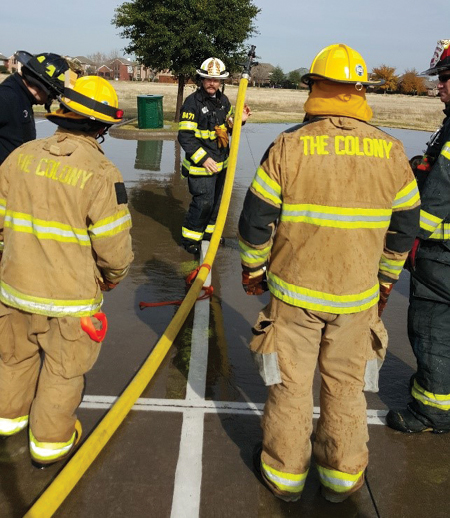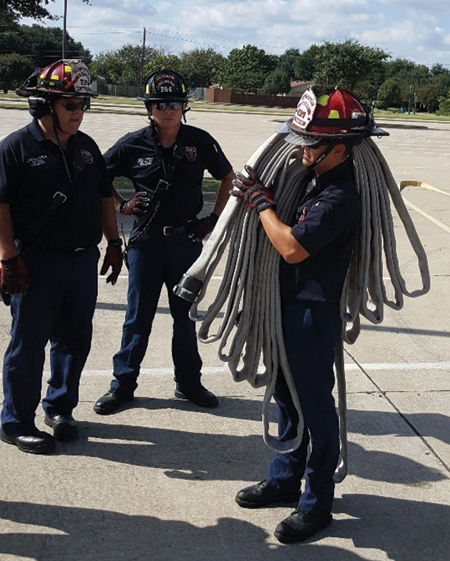BY J. SCOTT THOMPSON
Did you ever take the time to define what successful training looks like? When you think about it, training can be very basic and very complex at the same time. Technique training is a basic level of training that typically affects one person. Strategic training, on the other hand, will likely influence the organization. Unfortunately, it is not uncommon to see training quality compromised for training quantity. Firefighting is a highly technical team activity when done right. To be successful, training for fire operations requires a focus on quality training and not just quantity.
Everyone in the organization contributes to the quality of training in one way or another. Sydney Finkelstein wrote in the January-February 2018 issue of the Harvard Business Review, “Exceptional leaders that I studied were teachers through and through. They routinely spent time in the trenches with employees, passing on technical skills, general tactics, business principles, and life lessons. Their teaching was informal and organic, flowing out of the task. And it had an unmistakable impact: Their teams and organizations were some of the highest-performing in their sectors” (photo 1).

(1) Successful leaders are teachers. A battalion chief is training candidates on hose technique. (Photos courtesy of The Colony Fire Department.)
Quality Training Roles
The fire chief provides the vision of success; establishes expectations for departmentwide training; establishes preparedness and performance standards; introduces initiatives; and provides continual support and feedback in relation to the vision, operational philosophy, and execution of established standards. The operations chief commonly is involved with developing expectations for battalion-level and, in many cases, company-level training priorities. Expectations that come from this level of the organization ensure operational consistency and predictability among battalions, shifts, and stations.
Training coordinators implement initiatives, develop training objectives for departmentwide training, identify reference material that supports standards, identify logistical needs, ensure training is properly documented and evaluated, and ensure lessons learned are distributed throughout the organization so that everyone learns from the training experience. Training officers, on the other hand, make the training personal and relevant to the organization and focus on teaching internal standards.
Shift commanders or battalion chiefs are in the best position to identify the training needs of the battalion. They should be actively involved in conducting battalion drills; multicompany drills that focus on operational coordination, ensuring the consistency and the quality of strategies and tactics; and training audits and providing ongoing support and feedback on the battalion’s training efforts.
Company officers are in the best position to identify company-level training needs. Company-level success requires the company officer to be actively involved in training on tactics and tasks, coaching individual technique, and identifying any performance issues. Company officers also have the responsibility to ensure drills and training are properly documented and that lessons learned are passed on (photo 2).

(2) Company officers set the standard at the company level. The company officer is demonstrating what success looks like.
Senior, experienced members should be the primary technique coaches. The best senior members in an engine, truck, rescue, or squad company have learned to incorporate various visions of success from the organizational levels above them. This ensures each member is being positioned for success and not failure. Senior members are also in the best position to mentor and motivate the company during drills and training sessions.
Five Fives for Success
Each year in December, I practice one of Stephen Covey’s “7 Habits” (The 7 Habits of Highly Effective People, Simon & Schuster, 2013), specifically, #7: sharpen the saw. For 2018, I came up with five fives that I believe are a great place to start when drilling and training for successful delivery of fire, rescue, and emergency medical services. I suggest this only as a starting point, a foundation to build on.
When it comes to firefighting, nothing takes the place of relevant experience. However, the ideal situation is to develop firefighters and fire officers who have relevant experience and a strong knowledge base. You can’t do anything about the number of fires during each shift, but you can sharpen your saw each time you walk into the firehouse. The following are five knowledge action steps that I commit to each year.

(3) Senior members should be the most experienced technique coaches. Truck company members are reviewing saw techniques while performing a ventilation task.
#1: Read
It’s impossible to read too much. Whether it’s a training manual, trade journal, fire service-related book, or book that has nothing to do with the fire service, reading is essential for success. Today’s company officers and shift commanders must be well-rounded if they hope to successfully manage their firehouses or battalions. There are many great books that have nothing to do with the fire service but everything to do with dealing with people, problem solving, and decision making.
#2: Find a Mentor
Mentoring is the future of fire service learning. In the modern fire service, the ability to make training—and the job, for that matter—personal will directly impact short- and long-term success. Find a mentor who has the experience and knowledge, and look for opportunities to mentor someone else.
#3: Identify Role Models
Many great fire service role models, past and present, have made tremendous contributions to the fire service. Seek out those firefighters and fire officers who share your values and vision of fire service success, and then study their work. In my department, The Colony (TX) Fire Deparment, we have what we call Fredericks Friday. Every Friday, the work of the late Lieutenant Andrew Fredericks from the Fire Department of New York is put out to the department as part of the in-service training program so that we can continue to learn from his commitment to engine company operations. Make sure you choose your fire service role models for the right reasons. Make sure they walk the talk and not just talk.
#4: Commit to Continual Improvement
The mental and physical aspects of success and survival are paramount. While you are investing physically, make the commitment to improve mentally. As you get older, this job will take a mental and physical toll. The best way to combat the mental and physical damage is to stay on top of it and always commit to improving. Once you stop going forward, you begin going backward. If you don’t want to do it for yourself and your fire family, do it for your family at home.
#5: Define Success
It’s very difficult to prepare for and achieve success if you don’t know what success looks like. Take the time to decide if you want to be an employee working at a job, average, above average, or an elite firefighter. Once you decide what success looks like, work backward and identify the preparation, actions, and decisions necessary to get you there. Sit down and seriously evaluate your plan and your progress, and always look for ways to stay motivated (photo 4).

(4) Position people for success. When members move to the truck company, they are trained on the tactics, tasks, and techniques necessary for success. In this example, the positions that will perform vertical ventilation are trained for success, and the tasks associated with the position are well-rehearsed and supervised by members who know what success looks like and how to get there.
If you are in a supervisory role or hope to be, define what supervisory and leadership success looks like. Do you want your company to be average or elite performers? It can be your leadership that gets the company there or that keeps them from getting there. In the fire service, not doing (failing to prepare mentally, physically, mechanically, and procedurally) can be every bit as destructive as doing the wrong thing.
Choose Your Basic Big Five
Take the time to identify five basics, and then commit to mastering each of the five. Make it a personal goal to be the best in the department in at least one of your big five. If you are a company officer or shift commander, challenge those in your charge to do the same.
Want to take it a step further? Identify 100 things, and commit to doing one percent better in each during each year—whether it’s getting to work five minutes earlier, rereading a report before turning it in, spending five minutes of additional one-on-one time with each member of the crew, or eating better at one meal. Imagine if every member of the department committed to being just one percent better at 100 things each year. Every year, each member would grow by 100 percent!
Next Five Minutes
Instead of letting yourself or your crew get distracted by all of the organizational noise that goes on in the firehouse every minute of every day, focus on being the best you can be in the next five minutes. In the next five minutes, you may go on a call, perform a station task, drill, or talk to a team member. Focus on being the best version of yourself during that five minutes. Unfortunately, it is not difficult to find people today who go out of their way to be the worst version of themselves. Shouldn’t the fire service be just a little better than that?
First Five Minutes
The first five to 15 minutes of an incident after the first parking brake is set will often determine how well the incident will go. The late Chief (Ret.) Alan Brunacini from the Phoenix (AZ) Fire Department would often say, “The first five minutes will determine the next five hours.” This should motivate us to become really, really good at solving the incident problems in the early stages. Again, if you clearly define operational success, you can then work backward and develop an operational philosophy and a deployment model that best position you to achieve that operational success.
I don’t believe there is an experienced firefighter out there who can argue with the value of coordinated tactics and tasks. Make the first five minutes count. Lead out quickly and efficiently, mask up quickly, address search with a sensible level of aggression, identify and control the flow paths, and get water on the seat of the fire as soon as possible. Be able to support your chosen level of aggression. Focus training and drilling on learning how to fight fire better and not on a policy of justifying fighting fire less.
Next Five Years
The final five I want to discuss involve taking the time to define where you want yourself, your crew, your battalion, or your department to be in the next five years. What does the future look like from your position? What can you personally do to make the next five years look like your vision of success? Change takes time. A lot can happen in five years. You can start initiating change now, or you can continue to do nothing and complain about all that is wrong five years from now.
J. SCOTT THOMPSON joined the fire service in 1981 after graduating from the Texas Engineering Extension Service recruit class number 36 and has a bachelor’s degree in emergency administration and planning. He is chief of The Colony (TX) Fire Department. Thompson has been a H.O.T., workshop, and classroom instructor at FDIC International since 2002. He is the author of The Functional Fire Company, Positioning Smalls Groups for Success and Survival (Fire Engineering, 2018).

